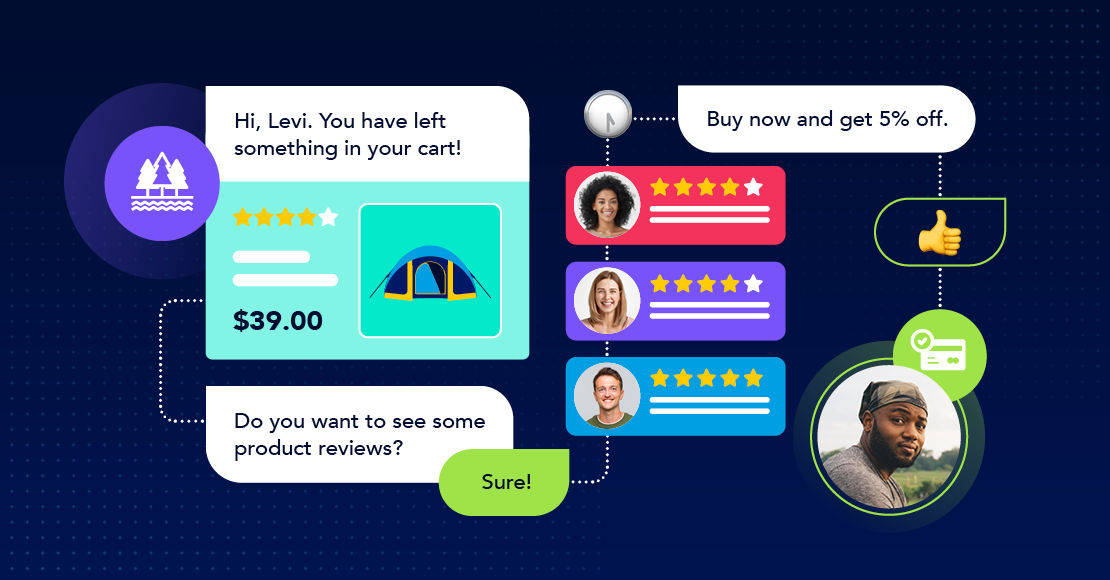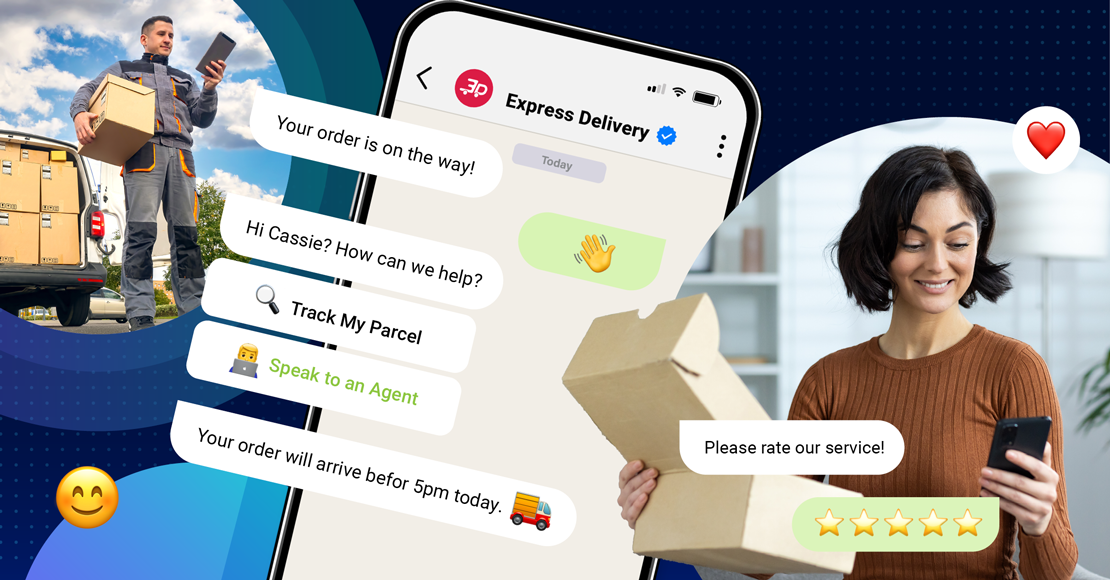
“In this ‘want it now’ culture where accessibility and instant gratification are two of the leading factors in securing sales, if a customer can’t quickly find a product or the information they’re looking for, or they don't have a way to receive answers to their questions instantly, they may abandon your site without a second thought.” - Forbes
Marketing remained stagnant for several decades as getting a brand’s message across relied on print media, billboards, radio and then television. The internet and associated digital age blew this wide open. The introduction of email marketing became more mainstream, but the arrival of the smartphone took this even further. Now chat commerce has become the pinnacle of marketing solutions, delivering personalised commerce experiences directly into your customers’ hands in real-time, every day.
What does ‘conversational commerce’ mean?
This is a way for retailers and service providers to engage directly with their customers and customers-to-be using messaging apps. This goes beyond typical customer communication to create personalised experiences that engage customers on their preferred platforms such as WhatsApp, WeChat, Facebook Messenger, or SMS. Conversational Commerce often includes these components:
Live chat: This is where a live chat agent can engage directly with the customer – or several customers – to facilitate sales. This is a great way to proactively engage your customers, share information that could be of use to them, and finally secure those sales.
Chatbots: To ease the burden on your live agents, you can also incorporate chatbots into your conversational commerce platform. This delivers a conversational experience with predetermined answers for those frequently asked questions.
Messaging apps: You can use Facebook Messenger, WhatsApp or other preferred apps to communicate with your customers via instant messaging.
Voice assistants: This software allows customers to search and buy while talking rather than typing. This is great for multitasking and is becoming much more popular as the software develops.
How does this differ from Chat Commerce?
Chat Commerce is essentially the next wave in Conversational Commerce that focuses on creating vertical-specific, rich, end-to-end commerce experiences using modern messaging platforms rather than legacy communication channels. Chat Commerce is a mobile-dedicated commerce solution where transactions are conducted on the world’s biggest chat apps.
Which industries benefit from Chat Commerce?
Chat Commerce, or evolved conversational commerce, is being adopted across a range of industries, but certain key industries are leading the way. These include:
1. Banking
Financial service providers can communicate more effectively with their clients over chat platforms. Alongside the marketing opportunities in terms of upselling and cross-selling, they can alert customers to fraud, provide notifications, facilitate transactions, and assist in applications for new cards.
2. Airline
Travel and tourism are in demand right now which is why tailored marketing approaches work best. Airlines can share discounts and notifications directly with customers, encourage last-minute bookings through deals and even work with other operators such as hotels and tour operators. Check-ins, lost luggage, and flight changes are just some of the options available via chat.
3. Telecommunications
It’s the logical trajectory that telecommunications providers are incorporating chat commerce to engage with their clients. They can share details about data discounts, market the latest mobile phones and tablets and provide real-time support to customers. All account management can be facilitated here as well, including monthly payments.
4. Utilities
This is the ideal platform to share worthwhile information such as energy-saving tips, alerts to any power outages and updates on outstanding amounts owed. All utility bill payments can be conducted over chat commerce.
5. Retail
The eCommerce industry is expanding exponentially, and marketing is what sets anyone apart. By engaging with customers through Chat Commerce, you’re able to tailor your approach and meet their needs quickly and easily. From finding your product to securing a sale can all be done on the platform in a matter of minutes.
6. Healthcare
Pharmaceutical and healthcare companies are learning to operate remotely following the pandemic, and realising the many benefits. Customers can learn more about medications, side effects and healthy living with tips shared via Chat Commerce. There are many benefits, from prescription refills to order tracking and appointment reminders.
What are the stages of Chat Commerce marketing?
You can view the impact of Chat Commerce in its various stages of customer engagement. Here’s how it works.
Stage 1: Customer awareness
This is the first stage of engagement through chat platforms when a customer realises they have a problem or a need and are looking for ways to address this. Typically, the first thing they will do is either contact someone for a word-of-mouth recommendation, or they will turn to the internet and start searching. This is where Chat Commerce on your website is beneficial as you’re making customers aware of your products or services.
Stage 2: Customer suggestions
The customer is now on your site and has learnt a bit about you but they’re still wanting more information to convince them that your service or product is the best option. They know of the competing brands, so this is when you can engage with them on the chat platform and provide them with more details on what you offer that sets you apart.
Stage 3: Decision-making
You’ve given a great sales pitch via the Chat Commerce platform, and the customer has approached the check-out site. Unfortunately, the work is not done because cart abandonment rates remain high. In 2022, cart abandonment rates ranged from 98% for cruise travel to 50% for groceries, according to Statista. You need to provide reassurance that your product or service is the right one for them, which you can do by sharing brand statistics, customer feedback, or product guarantees.
Stage 4: Customer retention
Once you get to this point, it’s clear that your Chat Commerce has done the job, but you don’t want to lose a customer after one interaction. Retaining customers is much more cost-effective than trying to win over new ones, so you need to do all that you can to continue this relationship. Don’t harass the customer, but what you can do is send them alerts about product discounts and launches, or other correspondence that would be useful to them.
Stage 5: Customer recommendations
You can even use the Chat Commerce platform to encourage your customers to become brand ambassadors. Through their recommendations, your customers can benefit from further discounts or other loyalty programme advantages. If you’ve engaged well enough on the Chat Commerce platform, this should be an organic next stage whereby customers are happy to recommend you via word-of-mouth marketing.
Tips for using Chat Commerce in marketing
Chat Commerce will drive revenue through its marketing opportunities, but you need to ensure that you’re taking the right approach when implementing the chat platform. Here are a few tips to guide you on your way.
Make it personal: One of the biggest drivers of chat is that it provides solutions in real-time, but modern customers want more than this – they want a personal experience. Tailor the chat platform to the individual customer using past chats and purchases as a baseline from which to work. This drives both brand loyalty and sales.
Make it convenient: You must ensure the chat box is well-integrated and that your customers are enjoying a disruption-free experience that doesn’t disappoint. You only have a short space of time to grab and retain customer attention, so ease of use is key.
If you’re looking to elevate your marketing approach with chat commerce, then Clickatell is the industry leader. This mobile-first chat commerce solution will provide your customers with the support they need to remain loyal to your brand.
Step into the future of business messaging.
SMS and two-way channels, automation, call center integration, payments - do it all with Clickatell's Chat Commerce platform.








